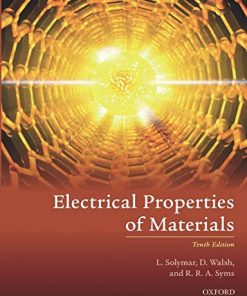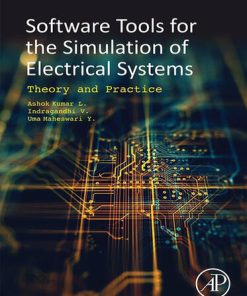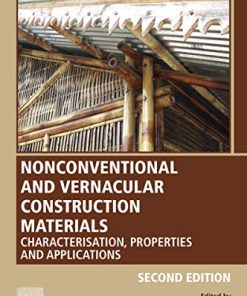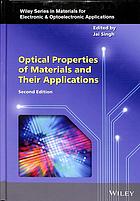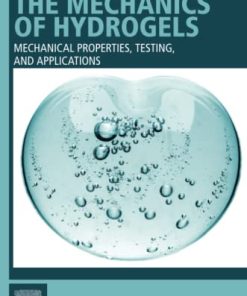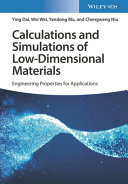(EBook PDF) Electrical Properties of Materials 10th Edition by Solymar, Walsh, Syms 0192565567 9780192565563 full chapters
$50.00 Original price was: $50.00.$25.00Current price is: $25.00.
Electrical Properties of Materials 10th Edition by L. Solymar, D. Walsh, A. R. A. Syms – Ebook PDF Instant Download/DeliveryISBN: 0192565567, 9780192565563
Full download Electrical Properties of Materials 10th Edition after payment.
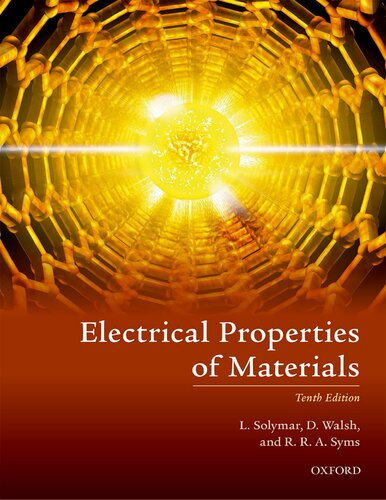
Product details:
ISBN-10 : 0192565567
ISBN-13 : 9780192565563
Author: L. Solymar, D. Walsh, A. R. A. Syms
An informal and highly accessible writing style, a simple treatment of mathematics, and clear guide to applications have made this book a classic text in electrical and electronic engineering. The fundamental ideas relevant to the understanding of the electrical properties of materials are emphasized; in addition, topics are selected in order to explain the operation of devices having applications (or possible future applications) in engineering. The mathematics, kept deliberately to a minimum, is well within the grasp of undergraduate students. This is achieved by choosing the simplest model that can display the essential properties of a phenomenom, and then examining the difference between the ideal and the actual behaviour. The whole text is designed as an undergraduate course. However most individual sections are self contained and can be used as background reading in graduate courses, and for interested persons who want to explore advances in microelectronics, lasers, nanotechnology, and several other topics that impinge on modern life.
Electrical Properties of Materials 10th Table of contents:
1. The electron as a particle
1.1 Introduction
1.2 The effect of an electric field—conductivity and Ohm’s law
1.3 The hydrodynamicmodel of electron flow
1.4 The Hall effect
1.5 Electromagnetic waves in solids
1.6 Waves in the presence of an appliedmagnetic field: cyclotron resonance
1.7 Plasma waves
1.8 Johnson noise
1.9 Heat
Exercises
2. The electron as a wave
2.1 Introduction
2.2 The electron microscope
2.3 Some properties of waves
2.4 Applications to electrons
2.5 Two analogie
Exercises
3. The electron
3.1 Introduction
3.2 Schrödinger’s equation
3.3 Solutions of Schrödinger’s equation
3.4 The electron as a wave
3.5 The electron as a particle
3.6 The electron meeting a potential barrier
3.7 Two analogies
3.8 The electron in a potential well
3.9 The potential well with a rigid wall
3.10 The uncertainty relationship
3.11 Philosophical implications
Exercises
4. The hydrogen atom and the4 periodic table
4.1 The hydrogen atom
4.2 Quantum numbers
4.3 Electron spin and Pauli’s exclusion principle
4.4 The periodic table
Exercises
5. Bonds
5.1 Introduction
5.2 General mechanical properties of bonds
5.3 Bond types
5.3.1 Ionic bonds
5.3.2 Metallic bonds
5.3.3 The covalent bond
5.3.4 The van der Waals bond
5.3.5 Mixed bonds
5.3.6 Carbon again
5.4 Feynman’s coupledmode approach
5.5 Nuclear forces
5.6 The hydrogen molecule
5.7 An analogy
Exercises
6. The free electron6 theory of metals
6.1 Free electrons
6.2 The density of states and the Fermi–Dirac distribution
6.3 The specific heat of electrons
6.4 The work function
6.5 Thermionic emission
6.6 The Schottky effect
6.7 Field emission
6.8 The field-emissionmicroscope
6.9 The photoelectric effect
6.10 Quartz–halogen lamps
6.11 The junction between two metals
Exercises
7. The band theory of solids
7.1 Introduction
7.2 The Kronig–Penneymodel
7.3 The Ziman model
7.4 The Feynmanmodel
7.5 The tight binding model
7.6 The effectivemass
7.7 The effective number of free electrons
7.8 The number of possible states per band
7.9 Metals and insulators
7.10 Holes
7.11 Divalent metals
7.12 Finite temperatures
7.13 Concluding remarks
Exercises
8. Semiconductors
8.1 Introduction
8.2 Intrinsic semiconductors
8.3 Extrinsic semiconductors
8.4 Scattering
8.5 A relationship between electron and hole densities
8.6 III–V and II–VI compounds
8.7 Non-equilibrium processes
8.8 Real semiconductors
8.9 Amorphous semiconductors
8.10 Measurement of semiconductor properties
8.10.1 Mobility
8.10.2 Hall coefficient
8.10.3 Effective mass
8.10.4 Energy gap
8.10.5 Carrier lifetime
8.11 Preparation of pure and controlled-impurity single-crystal semiconductors
8.11.1 Crystal growth from the melt
8.11.2 Zone refining
8.11.3 Modern methods of silicon purification
8.11.4 Epitaxial growth
8.11.5 Molecular beam epitaxy
8.11.6 Metal–organic chemical vapour deposition
8.11.7 Hydride vapour phase epitaxy (HVPE) for nitride devices
Exercises
9. Principles of semiconductor9 devices
9.1 Introduction
9.2 The p–n junction in equilibrium
9.3 Rectification
9.4 Injection
9.5 Junction capacity
9.6 The transistor
9.7 Metal–semiconductor junctions
9.8 The role of surface states; real metal–semiconductor junctions
9.9 Metal–insulator–semiconductor junctions
9.10 The tunnel diode
9.11 The backward diode
9.12 The Zener diode and the avalanche diode
9.12.1 Zener breakdown
9.12.2 Avalanche breakdown
9.13 Varactor diodes
9.14 MOSFET
9.15 Heterostructures
9.16 Wide bandgap semiconductors (WBG)
9.17 Charge-coupled devices
9.18 Silicon controlled rectifier
9.19 The Gunn effect
9.20 Strain gauges
9.21 Measurement ofmagnetic field by the Hall effect
9.22 Gas sensors
9.23 Microelectronic circuits
9.24 Plasma etching
9.25 Recent techniques for overcoming limitations
9.26 Building in the third dimension
9.27 Microelectro-mechanical systems (MEMS)
9.27.1 A movable mirror
9.27.2 A mass spectrometer on a chip
9.28 Nanoelectronics
9.29 Social implications
Exercises
10. Dielectric materials
10.1 Introduction
10.2 Macroscopic approach
10.3 Microscopic approach
10.4 Types of polarization
10.5 The complex dielectric constant and the refractive index
10.6 Frequency response
10.7 Anomalous dispersion
10.8 Polar and non-polar materials
10.9 The Debye equation
10.10 The effective field
10.11 Acoustic waves
10.12 Dielectric breakdown
10.12.1 Intrinsic breakdown
10.12.2 Thermal breakdown
10.12.3 Discharge breakdown
10.13 Piezoelectricity, pyroelectricity, and ferroelectricity
10.13.1 Piezoelectricity
10.13.2 Pyroelectricity
10.13.3 Ferroelectrics
10.14 Interaction of optical phonons with drifting electrons
10.15 Optical fibres
10.16 The Xerox process
10.17 Liquid crystals
10.18 Dielectrophoresis
Exercises
11. Magneticmaterials
11.1 Introduction
11.2 Macroscopic approach
11.3 Microscopic theory (phenomenological)
11.4 Domains and the hysteresis curve
11.5 Softmagneticmaterials
11.6 Hardmagneticmaterials (permanentmagnets)
11.7 Microscopic theory (quantum-mechanical)
11.7.1 The Stern–Gerlach experiment
11.7.2 Paramagnetism
11.7.3 Paramagnetic solids
11.7.4 Antiferromagnetism
11.7.5 Ferromagnetism
11.7.6 Ferrimagnetism
11.7.7 Garnets
11.7.8 Helimagnetism
11.8 Magnetic resonance
11.8.1 Paramagnetic resonance
11.8.2 Electron spin resonance
11.8.3 Ferromagnetic, antiferromagnetic, and ferrimagnetic resonance
11.8.4 Nuclear magnetic resonance
11.8.5 Cyclotron resonance
11.9 The quantum Hall effect
11.9.1 Metrology
11.10 Magnetoelectric effect
11.11 Biferroics
11.12 Magnetoreception
11.13 Magnetoresistance
11.14 Spintronics
11.14.1 Spin current
11.14.2 Spin tunnelling
11.14.3 Spin waves and magnons
11.14.4 Spin Hall effect and its inverse
11.14.5 Spin and light
11.14.6 Spin transfer torque
11.14.7 Spins producing nematic phase
11.15 Some applications
11.15.1 Isolators
11.15.2 Sensors
11.15.3 Magnetic read-heads
11.15.4 Electric motors
Exercises
12. Lasers
12.1 Equilibrium
12.2 Two-state systems
12.3 Lineshape function
12.4 Absorption and amplification
12.5 Resonators and conditions of oscillation
12.6 Some practical laser systems
12.6.1 Solid-state lasers
12.6.2 The gaseous discharge laser
12.6.3 Dye lasers
12.6.4 Gas-dynamic lasers
12.6.5 Excimer lasers
12.6.6 Chemical lasers
12.6.7 Fibre lasers
12.7 Semiconductor lasers
12.7.1 Fundamentals
12.7.2 Wells, wires, and dots
12.7.3 Bandgap engineering
12.7.4 Quantum cascade lasers
12.8 Laser modes and control techniques
12.8.1 Transverse modes
12.8.2 Axial modes
12.8.3 Q switching
12.8.4 Cavity dumping
12.8.5 Mode locking
12.9 Parametric oscillators
12.10 Optical fibre amplifiers
12.11 Masers
12.12 Noise
12.13 Applications
12.13.1 Nonlinear optics
12.13.2 Spectroscopy
12.13.3 Photochemistry
12.13.4 Study of rapid events
12.13.5 Plasma diagnostics
12.13.6 Plasma heating
12.13.7 Acoustics
12.13.8 Genetics
12.13.9 Metrology
12.13.10 Manipulation of atoms by light
12.13.11 Optical radar
12.13.12 Optical discs
12.13.13 Medical applications
12.13.14 Machining
12.13.15 Sensors
12.13.16 Communications
12.13.17 Nuclear applications
12.13.18 Holography
12.13.19 Laser printing
12.13.20 Raman scattering
12.14 The atom laser
Exercises
13. Optoelectronics
13.1 Introduction
13.2 Light detectors
13.3 Light emitting diodes (LEDs)
13.3.1 Operation
13.3.2 Advantages, disadvantages, and applications
13.4 Electro-optic, photorefractive, and nonlinearmaterials
13.5 Volume holography and phase conjugation
13.6 Acousto-optic interaction
13.7 Opto-acoustic interaction
13.8 Integrated optics
13.8.1 Waveguides
13.8.2 Phase shifter
13.8.3 Directional coupler
13.8.4 Filters
13.9 Spatial light modulators
13.10 Nonlinear Fabry–Perot cavities
13.11 Optical switching
13.12 Electro-absorption in quantum well structures
13.12.1 Excitons
13.12.2 Excitons in quantum wells
13.12.3 Electro-absorption
13.12.4 Applications
Exercises
14. Superconductivity
14.1 Introduction
14.2 The effect of amagnetic field
14.2.1 The critical magnetic field
14.2.2 The Meissner effect
14.3 Microscopic theory
14.4 Thermodynamical treatment
14.5 Surface energy
14.6 The Landau–Ginzburg theory
14.7 The energy gap
14.8 Some applications
14.8.1 High-field magnets
14.8.2 Switches and memory elements
14.8.3 Magnetometers
14.8.4 Metrology
14.8.5 Suspension systems and motors
14.8.6 Radiation detectors
14.8.7 Heat valves
14.9 High-Tc superconductors
14.10 New superconductors
14.11 Quantum computers and the superconducting qubit
14.11.1 Introduction
14.11.2 Josephson junctions again
Exercises
15. Artificial materials or metamaterials
15.1 Introduction
15.2 Natural and artificialmaterials
15.3 Photonic bandgap materials
15.4 Equivalent plasma frequency of a wire medium
15.5 Resonant elements for metamaterials
15.6 Polarizability of a current-carrying resonant loop
15.7 Effective permeability
15.8 Effect of negative material constants
15.9 The ‘perfect’ lens
15.10 Detectors for magnetic resonance imaging
People also search for Electrical Properties of Materials 10th:
importance of electrical properties of materials
explain the electrical properties of materials
mechanical and electrical properties of materials
how are the electrical properties of materials quantified
electrical properties of materials pdf
Tags:
Electrical Properties,Materials,Solymar,Walsh,Syms
You may also like…
Erotica - Fiction
Engineering
Housekeeping & Leisure - Interior Design & Decoration
(Ebook PDF) Electrical Wiring Industrial 16th Edition by Stephen Herman 9798214342085 full chapters
Uncategorized
Engineering - Mechanical Engineering & Dynamics




